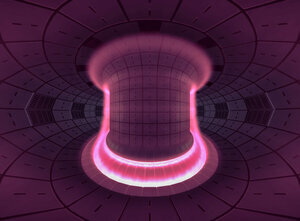
College of Engineering Unit:
Fusion energy researchers at the Lawrence Livermore National Laboratory in California have achieved a long-awaited milestone in simulating the sun's power in a lab.
That prompted public excitement as fusion, the nuclear reaction that makes stars shine could be a future source of copious energy. Although fusion energy has been marketed as a clean and plentiful source of energy, it does produce radioactive waste (de Vicente et al, 2022).
The main objectives are to compare the differences between the waste generated by non-conventional nuclear reactors and that produced by conventional nuclear reactors, identify any specific radionuclides of concern, acquire sufficient knowledge about the characteristics of these radionuclides to ensure safe management practices, assess whether the existing US regulatory framework can effectively manage this waste or if new regulations need to be developed, and determine if the creation of new waste disposal facilities is necessary to accommodate this type of waste.
The fusion reactor risk is much less than the fission reactor’s because there is no nuclear material used in the fusion reactor. Moreover, in fusion reactors, there is no self-sustained chain reaction which reduces the radioactive risk (NRC Staff Prepared White Paper).
Fusion energy has been promoted as clean energy mostly as a result of the absence of production of high-level waste. It is low-level waste and intermediate-level waste. However, the quantity of fusion waste is much larger than that of the fission reactors (de Vicente et al, 2022).
There are two areas that must be focused on in the fusion energy system which are the inventory of activated materials, and the neutron produced during the operation. In the first area, the radionuclides of concern in fusion reactors were found to be tritium, carbon-14, and activation products. In the second area, the material used in the wall of the reactor might become radioactive because of the high neutron produced during the operation of the reactor. Although most think that fusion reactors do not have any radionuclides of concern. There are still radionuclides that are emitted in fusion reactors. The radionuclides that are of concern in fusion reactors are Tritium, Carbon-14, and activation products.The cleanup and recycling of fusion radioactive materials, with a focus on their reuse in the nuclear industry, have become significant considerations for fusion energy plant designers. Compared to fission reactors, fusion energy plants produce a higher volume of radioactive waste, necessitating attention to waste management. To address this, it is crucial to redesign the fusion waste management process and prioritize material reuse through recycling and clearance procedures. These measures serve multiple purposes: they help reduce the environmental impact of fusion energy, create more storage space by minimizing waste volume, reclaim valuable resources by reducing the need for extensive mining of metal alloys, and facilitate the reuse of concrete rubble. Ultimately, these initiatives can lead to substantial cost savings by minimizing high disposal expenses associated with fusion radioactive waste.
The existing US low-level waste repositories will quickly become filled with the sizeable number of intermediate radioactive materials that produced from fusion reactors. Therefore, the fusion studies neglected the potential issue of fusion radioactive waste, treating it as merely a disposal problem.The focus on transformative technologies was sparked by worries about the environment, a shortage of waste repositories, excessive disposal costs, and the weight of radioactive waste on future generations (Idaho National Laboratory). Because there are no particular laws for fusion energy at the moment, the Nuclear Regulatory Commission (NRC) applies its fission power plant radioactive waste regulations to fusion waste as well (de Vicente et al., 2022). According to the NRC, there are two forms of radioactive waste. Extremely dangerous high-level garbage must be disposed of at depths of 600-800 meters below the surface. Low-level waste, which is relevant to fusion trash, on the other hand, may be disposed of in near-surface repositories. It should be noted, however, that not all radionuclides generated in fusion are covered by the NRC's restrictions listed in 10CFR61.
The large majority of the latest fusion research revealed that the recycling/clearance strategy is fairly simple to conceptualize and implement from a scientific standpoint. But, from the standpoint of politics, regulation, and public acceptance, it is particularly difficult in the US.